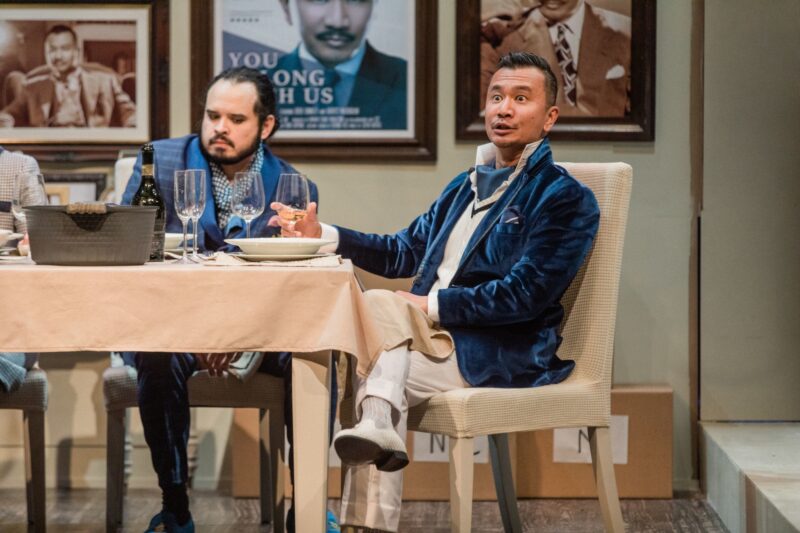Two Mile Hollow Delivers a Worthwhile Message but is Muddled in Execution
Review of Two Mile Hollow presented by Intiman Theatre
Written by Teen Writer Yoon Lee and edited by Teen Editor Esha Potharaju

My experience with Two Mile Hollow was not what I anticipated. This subversion of my expectations works both for and against it.
I came into it hoping it would lean into the irony of its premise–satirize a petty rich white family by casting Asian American Pacific Islander actors for each role. The promise of seeing something akin to The Mystery of Irma Vep, which used two actors in cross-gender roles to lampoon traditional Victorian gender roles, was what drew me to Two Mile Hollow in the first place. Its deficiency in this department was why it was a disappointment.
The play follows the antics of the Donnelly's, a “very white family with very white problems.” This dysfunctional group of “white people” consists of the widow, Blythe (Naho Shioya), Christopher (Ray Tagavilla), Mary (Annie Yim), Joshua (M. Keale Miles, Jr.), and Charlotte (MJ Daly). The father of the family, a famous movie star, has passed away, so his children and widow return to the Two Mile Hollow estate to divide the contents before selling the home. His son Christopher, also a famous actor, brings his personal assistant Charlotte. The play examines how she is forced to decide where she fits in this situation as an Asian woman.
As a Korean American teenager who participates in various non-traditionally “Asian” fields and interests, the message Two Mile Hollow attempts to convey with the invisibility, erasure, and exploitation of Asians–and particularly Asian women–in media is incredibly important to have. This play simply existing is a net positive, and moreover, I enjoyed the theatrical skill of its actors.
Each actor portrayed their assigned roles nigh-perfectly, the only character breaks being intentional to drive home a comedic point (the so-called “Office stare,” except actually executed tastefully). Ray Tagavilla especially stood out as Christopher, who pulled off the stoic, dominating, and confident superstar archetype very well with his well-projected voice. He demonstrated his range by portraying Christopher losing his composure at convenient moments, which produced hilarious results. I also thought MJ Daly shone as Charlotte, portraying her sassy but sincere character impeccably, especially impressive given it is their debut performance with Intiman.
Despite its centering of Asian narratives and skillful actors, I think the plot and dialogue were middling.

I particularly disliked Mary. She had her moments, but overall the character felt obnoxious and overly loud. While I understand that the point of her ridiculous behavior was to emphasize the cliched, overly-emotional-daughter character, she was by far the character that made me the most uncomfortable. On top of an incest subplot where she expresses feelings for her step-brother (that thankfully goes nowhere), there is a protracted, several-minute scene involving all the characters where she furiously masturbates from a balcony. I also object to the incest subplot because, on top of the obvious discomfort it invokes, it perpetuates sexual harassment and assault toward men as a source of comedy.
One twist of the play that its advertising cleverly left out is the character Charlotte, who, contrary to what her lack of presence in the advertising suggests, actually drives the entire plot as its main character. Here I must give points, as focusing on this character both upsets the cliche of the throwaway Asian woman secretary, and offers a meta-commentary on how Asian women in the entertainment industry are made invisible. As such, the choice to not include her in the poster is subtly genius. The problem with this choice, and with Charlotte in general, is that the play tries to then convey two connected, but ultimately different, messages–the frivolity of rich white families, and the invisibility of Asian women in entertainment. Consequently, neither feel like they get appropriate attention–the comedic potential of the former element appears consistently but with varying levels of success, and the comedy imbued in the latter feels dissonant given the much more serious subject matter.
Charlotte being Asian in-story also creates some confusion, and makes it harder to suspend one’s disbelief when viewing a white family portrayed by Asian actors. To clarify this dilemma, the script includes a handful of heavy-handed jokes–the matriarch of the family refers to people of color with disdain, and each member of the family misidentifies Charlotte’s ethnicity. However, this results in the jokes feeling forced, feeling more like a family of exceptionally “white” Asian Americans being horrible to another Asian woman in entertainment. Of course that type of story is important to tell, with the model minority myth and class divides being a worthwhile phenomena to dissect, but bypasses the play’s purpose.
Near the end, though, Two Mile Hollow commits the cardinal sin of satire: it takes five minutes to blatantly state the message of the play with an unnaturally didactic exchange of dialogue about how Asian representation is lacking and how white people may feel threatened by criticisms of this problem, subtlety be damned. This isn’t even an isolated instance, as there is a choreographed dance number about how women are “rated” by beauty standards. These scenes jump out of the blue both tonally and narratively, causing the messages to lose their impact due to dissonant execution.
I could get past the flaws of Two Mile Hollow, from cases of clunky writing, uncomfortable characters, and flat comedy, because I think even the existence of such a play that highlights the importance of Asian American representation is a massive step forward, and I thank it if only for taking that position. Ultimately, though, I wish I could have enjoyed it more; the valuable themes come across, but in a manner I found sloppy.
Lead Photo: Photo by Joe Moore for Intiman Theatre.
The TeenTix Newsroom is a group of teen writers led by the Teen Editorial Staff. For each review, Newsroom writers work individually with a teen editor to polish their writing for publication. The Teen Editorial Staff is made up of 6 teens who curate the review portion of the TeenTix blog. More information about the Teen Editorial Staff can be found HERE.
The TeenTix Press Corps promotes critical thinking, communication, and information literacy through criticism and journalism practice for teens. For more information about the Press Corps program see HERE.


